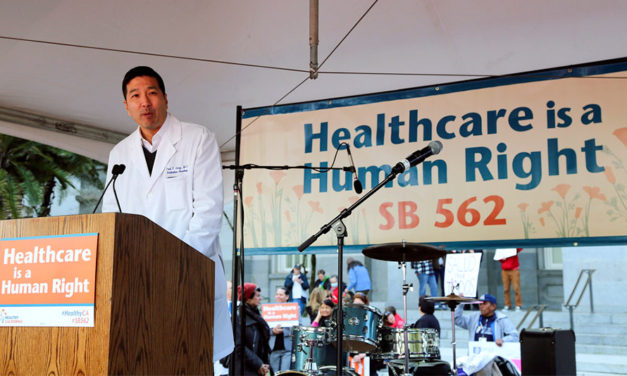 This article, by Dr. Paul Y. Song, Physician, Co-Chair Campaign for a Healthy California, and Board Member of Physicians for a National Health Program, appeared on HuffingtonPost on 4/24/17. The original article is available here.
This article, by Dr. Paul Y. Song, Physician, Co-Chair Campaign for a Healthy California, and Board Member of Physicians for a National Health Program, appeared on HuffingtonPost on 4/24/17. The original article is available here.
The Affordable Care Act (ACA) commonly known as Obamacare expanded healthcare coverage to approximately 4.6 million Californians and cut the uninsured rate in the Golden state from 16% in 2013 to 8.6% in 2016.
Despite over 60 attempts by Republicans under President Obama to repeal the ACA, and one recently botched effort under President Trump, the overall threat of a radically weakened ACA remains, placing the healthcare of millions of Californians at constant risk. It also leaves California in a constant state of financial uncertainty with regard to its aggressive Medicaid expansion.
Yet, even without any GOP repeal, 2.9 million Californians remain uninsured, of which a third are undocumented, 75% are from communities of color, and approximately 250,000 are kids.
Because most of the ACA was largely written by the private insurance and pharmaceutical industries, the ACA had no provisions to regulate health insurance premiums or rising prescription drug costs. As a result insurance premiums have increased roughly 200% in the past 10 years in California and a recent Kaiser Family Foundation study shows that the number of insured Americans that have trouble affording their premiums has increased from 27 to 37 percent since 2015, while the number of folks who have trouble with their deductibles has increased from 34 to 43 percent.
Meanwhile, one in 10 seniors cannot afford their prescriptions and one-third of all insured Americans delay seeking care because they cannot afford their co-pays and deductibles, while medical illness remains the number one cause of bankruptcies.
To date, Covered California has one of the most limited exchanges in the country in terms of having 75% of all their plans with very narrow networks (patients have access to 25% or less of physicians in a defined area). And premiums for 2017 jumped an average of 13.2%, three times the increase within the past two years.
Healthcare benefits remain a major source of labor negotiation strife as workers are being forced to contribute more towards their own healthcare while companies are handcuffed by skyrocketing premiums, which leave less money for capital improvements and their own R&D.
And, California has a $150 Billion unfunded retiree healthcare liability that has never been addressed.
So what is California to do?
California’s fragmented multi-payer system takes upwards of 20 cents of every healthcare dollar away from actual patient care to spend towards administrative costs often used to deny care, marketing, overhead, and executive compensation. A 2005 study by the Lewin Group revealed that a “single payer” system rather than multiple insurers to oversee funding of a private healthcare delivery system would save California a minimum of $20 Billion in the first year alone in administrative savings. At the same time it would expand coverage to care for everyone without requiring massive new taxes or spending.
A 2016 study from the UCLA Center for Health Policy Research revealed that 71% of all healthcare expenditure in California in 2016 was paid for by taxpayers. Coupled with the previously mentioned administrative waste, Californians are essentially paying for universal healthcare, just not getting it.
California came close on two prior occasions to enacting a statewide single payer program. In 2005-2006 and 2007-2008 legislative sessions, then state senator Sheila Kuehl introduced SB840, which won approval by both houses, only to be vetoed twice by then Governor Arnold Schwarzenegger.
Since then, Sacramento has remained under the tight control of the private insurance industry and pharmaceutical industries as it has failed to pass any insurance rate regulation, drug-pricing controls, or another single payer bill.
That is until now. California Senate Bill 562, authored by Senators Ricardo Lara and Toni Atkins calls for a California Single Payer program. While some specifics still need to be worked out especially with regard to obtaining a federal waiver to incorporate Medicare, Medicaid, and S-Chip funds, it is clear that any such program already faces tremendous opposition from corporatist legislators.
The fact is that our legislators can no longer turn a blind eye while California remains hostage to a federal government run by a heartless majority who recklessly controls the purse strings in favor of tax cuts for the 1% while refusing to view healthcare as a right. As the 6th largest economy, California needs to think boldly and look at what all major industrialized nations do.
The answer has been there all along.
But, in order to get a healthcare program for the people, it must come from an unprecedented groundswell by the people. We must hold our elected officials publicly accountable and demand what we are already paying for and readily deserve. The ACA pointed our state and nation in the right direction, but the time for real universal healthcare is now and the opportunity to do so is golden and now!
Like this post? Consider sharing it on
